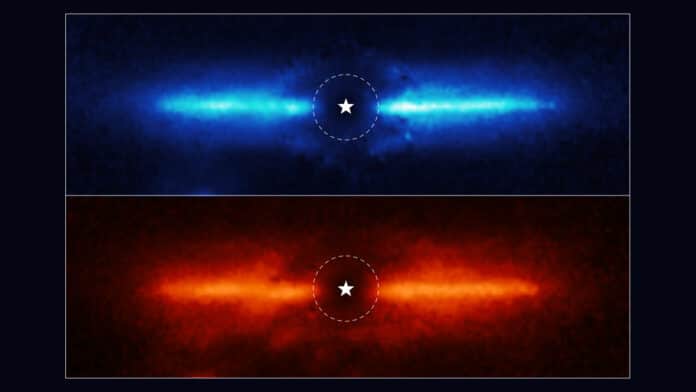The inside of a dusty disc surrounding a nearby red dwarf star has been captured by NASA’s James Webb Space Telescope. With these observations, the previously observed disc has been photographed for the first time at these infrared light wavelengths, revealing a disk-like never seen before. They also offer hints about the disk’s makeup.
Located 32 light-years away in the southern constellation Microscopium, the star system called AU Microscopii or AU Mic is almost 23 million years old. The planet’s formation has ended since that process typically takes less than 10 million years.
There are two planets within this star system. The dusty disk results from collisions between leftover planetesimals – a more massive equivalent of the dust in our solar system that creates a phenomenon known as zodiacal light.
The team investigated AU Mic using Webb’s Near-Infrared Camera (NIRCam). They analyzed the area near the star with NIRCam’s coronagraph, which deflects its bright light. The researchers could trace the disc as close to the star as five astronomical units (460 million miles), which is comparable to Jupiter’s orbit in our solar system, using the NIRCam photos.
Images were captured by the observing program at wavelengths of 3.56 and 4.44 microns. The team discovered that the disc was “bluer,” or brighter, at shorter wavelengths, indicating that it likely contains a lot of fine dust that is effective at scattering light at shorter wavelengths.
Kellen Lawson of NASA’s Goddard Space Flight Center, lead author on the study, said, “Collisions of planetesimals continuously replenish a debris disk. By studying it, we get a unique window into the recent dynamical history of this system.”
Josh Schlieder of NASA’s Goddard Space Flight Center, principal investigator for the observing program and a study co-author, said, “This system is one of the very few examples of a young star, with known exoplanets, and a debris disk that is near enough and bright enough to study holistically using Webb’s uniquely powerful instruments.”
“Our first look at the data far exceeded expectations. It was more detailed than we expected. It was brighter than we expected. We detected the disk closer in than we expected. We’re hoping that as we dig deeper, there will be some more surprises that we hadn’t predicted.”
This finding is consistent with the results of prior studies, which found that the radiation pressure from AU Mic — unlike that of more massive stars — would not be strong enough to eject fine dust from the disk.
Lawson said, “This is the first time that we have sensitivity to directly observe planets with wide orbits that are significantly lower in mass than Jupiter and Saturn. This is new, uncharted territory regarding direct imaging around low-mass stars.”
